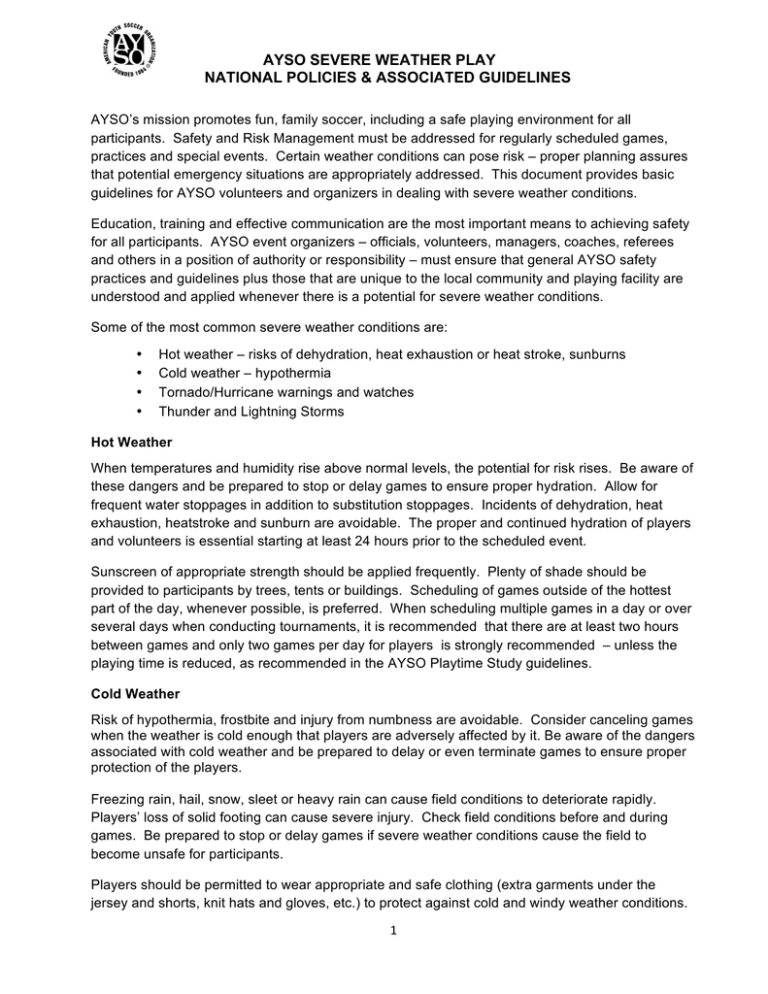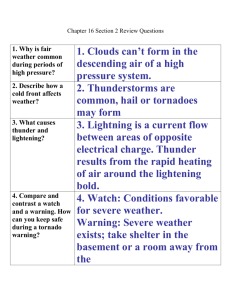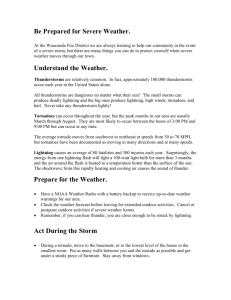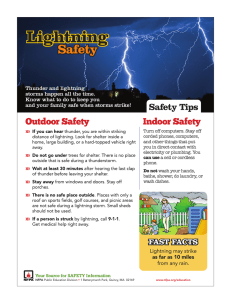AYSO`S Severe Weather Policy
advertisement

AYSO SEVERE WEATHER PLAY NATIONAL POLICIES & ASSOCIATED GUIDELINES AYSO’s mission promotes fun, family soccer, including a safe playing environment for all participants. Safety and Risk Management must be addressed for regularly scheduled games, practices and special events. Certain weather conditions can pose risk – proper planning assures that potential emergency situations are appropriately addressed. This document provides basic guidelines for AYSO volunteers and organizers in dealing with severe weather conditions. Education, training and effective communication are the most important means to achieving safety for all participants. AYSO event organizers – officials, volunteers, managers, coaches, referees and others in a position of authority or responsibility – must ensure that general AYSO safety practices and guidelines plus those that are unique to the local community and playing facility are understood and applied whenever there is a potential for severe weather conditions. Some of the most common severe weather conditions are: • • • • Hot weather – risks of dehydration, heat exhaustion or heat stroke, sunburns Cold weather – hypothermia Tornado/Hurricane warnings and watches Thunder and Lightning Storms Hot Weather When temperatures and humidity rise above normal levels, the potential for risk rises. Be aware of these dangers and be prepared to stop or delay games to ensure proper hydration. Allow for frequent water stoppages in addition to substitution stoppages. Incidents of dehydration, heat exhaustion, heatstroke and sunburn are avoidable. The proper and continued hydration of players and volunteers is essential starting at least 24 hours prior to the scheduled event. Sunscreen of appropriate strength should be applied frequently. Plenty of shade should be provided to participants by trees, tents or buildings. Scheduling of games outside of the hottest part of the day, whenever possible, is preferred. When scheduling multiple games in a day or over several days when conducting tournaments, it is recommended that there are at least two hours between games and only two games per day for players is strongly recommended – unless the playing time is reduced, as recommended in the AYSO Playtime Study guidelines. Cold Weather Risk of hypothermia, frostbite and injury from numbness are avoidable. Consider canceling games when the weather is cold enough that players are adversely affected by it. Be aware of the dangers associated with cold weather and be prepared to delay or even terminate games to ensure proper protection of the players. Freezing rain, hail, snow, sleet or heavy rain can cause field conditions to deteriorate rapidly. Players’ loss of solid footing can cause severe injury. Check field conditions before and during games. Be prepared to stop or delay games if severe weather conditions cause the field to become unsafe for participants. Players should be permitted to wear appropriate and safe clothing (extra garments under the jersey and shorts, knit hats and gloves, etc.) to protect against cold and windy weather conditions. 1 Tornado/Hurricane Warnings and Watches TORNADO WATCH: Tornadoes are possible in the area; remain alert for approaching storm. TORNADO WARNING: A Tornado has been sighted or indicated by weather radar. If a tornado warning is issued for your area and the sky becomes threatening, move to a pre-designated place of safety. When events and activities are calendared during tornado or hurricane seasons, it is important that all participants are well informed and have a plan of action for their occurrence. Upon notification of a tornado warning, all activities and events should be cancelled until weather conditions and field conditions allow the activity to resume. Recognizing the Danger – What to Look and Listen For Look out for dark, often greenish skies, and a wall cloud, large hail and loud roar similar to a freight train. If a warning is issued and you are indoors, stay away from windows and move to an interior room or hallway or the lowest floor; get under a sturdy piece of furniture if possible. At the fields or enroute, get out of automobiles, trailers or camping type vehicles. Hurricanes, for the most part, start out as thunderstorms. Thunderstorms intensify into tropical depressions, then into tropical storms and finally become hurricanes. Most hurricanes are tracked at least 7-10 days in advance. When information indicates that this type of severe weather is probable, the event should be postponed or cancelled. Thunder and Lightning Storms A lightning safety plan should be an integral part of the planning process for any outdoor event. Do not wait for storm clouds to develop before considering what to do should lightning threaten! An effective plan begins LONG before any lightning threat is realized. The key to an effective lightning safety action plan lies in answers to the following questions: 1. Where is the safest lightning shelter? 2. How far is the group from that location? 3. How long will it take to get the group there? Knowing the answers to these questions and formulating a plan of action accordingly is critical to reducing the chances of anyone being struck by lightning. *If a Region has a frequency of thunderstorms, then a safety policy should be posted on the Region’s Website, discussed in Safe Haven® courses, emphasized at all coach, referee and team parent orientation meetings and be contained in the Region Handbook distributed to participating families. *In tournament play or other special events, if there is a possibility of thunder and lightning storms, a pre-event meeting to assure that guidelines, safety procedures, duties and responsibilities are reviewed and clearly understood by all event staff and participants should be conducted. If this is not possible, then a communication plan should be incorporated to ensure this information is given to all participants and volunteers to ensure safe and orderly execution of emergency planning procedures. 2 *Event officials will consult and determine the course of action – give the “all clear” sign for games to resume, cancel the balance of ongoing games or cancel games for the day. Event administrators, Regional Commissioners or their designees, including Coach Administrator, Referee Administrator or referees, will have the authority, as so designated, to delay the start of play, call a halt in play or suspend/terminate a game due to severe weather conditions. Studies have shown that most people struck by lightning are struck not at the height of a thunderstorm, but before and after the storms have peaked. This is because lightning can strike as far as 10 miles from the area where it is raining and many people are unaware of how far lightning can strike from its originating thunderstorm. Recognizing the Danger – And Knowing What to Do *Many communities and parks systems have lightning detection and tornado warning systems in place as required by law. Obey the rules established at these facilities. When storm warning technology indicates severe weather danger, cease all field activities and seek shelter immediately. Know how to use the warning systems in place and heed all warnings even if you are told there is a possibility of a false alarm. When thunder is heard it is within striking distance. – seek shelter immediately. Do not wait for the rain to start before seeking shelter, and do not leave shelter just because the rain has ended. Enact the safety plan now! Restart games after no thunder has been heard for 30 minutes, or if there is a warning system in place, the community ALL CLEAR SIREN has been sounded. Distinguishing Between Safe and Unsafe Shelters NOTE: Remember, the time when activities are stopped is the time when people BEGIN to seek shelter. Adequate time should be allowed for them to seek shelter safely. Only the most important items should be retrieved such as purses, baby bags, car keys, etc. Delays retrieving all personal belongings raise the risk of danger. Safe Shelter Areas INSIDE a substantial building (roof AND completely enclosed walls) towards the middle of the building Except for tornadoes or hurricanes, INSIDE a fully enclosed metal vehicle with the windows completely closed. Unsafe Shelter Areas Around or near all metal objects: goals, flag poles, fences, gates, high mast light poles, bleachers. Around or near all trees, water, open fields, high ground. Around, near or in small buildings, picnic shelters, concession stands, tents. 3 If Caught Out in the Open NOTE: No place outside is safe when severe weather exists. Encourage all participants to seek shelter indoors. AVOID groups of people. Spread out to reduce the risk. Shield children. AVOID being the tallest object. Seek cover in clumps of bushes. CROUCH down as low as possible and cover your head with your forearms; assist children as they will most often be frightened. If Someone is Injured Call 9-1-1 immediately. If qualified to do so, apply CPR and First Aid, if necessary, until medical staff arrives. All safety personnel should be educated on what and when to act or react in severe weather conditions. NOTE: People who have been struck by lightning do not carry a charge and are safe to touch. Other Emergency Planning Wild fires, earthquakes and chemical disasters occur without warning. Having in place a safety plan for these variables and the ability to obtain air quality advisement reports is highly advisable. All safety plans need to be communicated by all means possible, e.g., in team packages or mailings, in the rules, Website, handouts at the fields, etc. prior to the event, in order that participants have the time to read, digest and discuss these extreme weather possibilities. This will ensure good communications and understanding of the emergency procedures as well as safe and efficient execution of evacuation procedures. Other Resources * National Policy Statement 2.10 http://www.ayso.org/Libraries/Resources/policy_statements.pdf and the AYSO Tournament Handbook http://www.ayso.org/Libraries/Resources/national_tournament_handbook.pdf should be consulted for additional information and guidance or contact the AYSO National Support & Training Center. 4 National Policy Statement Proposal Article Two: AYSO Activities National Policy Statement XXX: Severe Weather Thunderstorms and Lightning If a Region has a frequency of thunderstorms, a safety policy should be posted on the Region’s Website, discussed in Safe Haven® courses, emphasized at all coach, referee and team parent orientation meetings and be contained in the Region Handbook distributed to participating families. In tournament play or other special events, if there is a possibility of thunder and lightning storms, a pre-event meeting to assure that guidelines, safety procedures, duties and responsibilities are reviewed and clearly understood by all event staff and participants should be conducted. If this is not possible, then a communication plan should be incorporated to ensure this information is given to all participants and volunteers to ensure safe and orderly execution of emergency planning procedures. Event officials will consult and determine the course of action – give the “all clear” sign for games to resume, cancel the balance of ongoing games or cancel games for the day. Event administrators, Regional Commissioners or their designees, including Coach Administrator, Referee Administrator or referees, will have the authority, as so designated, to delay the start of play, call a halt in play or suspend/terminate a game due to severe weather conditions. (a) Many communities and parks systems have lightning detection and tornado warning systems in place. Obey the rules established by the community. When storm warning technology indicates severe weather danger, cease all field activities and seek shelter immediately. (b) Know how to use the warning systems in place and heed all warnings even if you are told there is a possibility of a false alarm. (c) When thunder is heard it is within striking distance. – seek shelter immediately. Do not wait for the rain to start before seeking shelter, and do not leave shelter just because the rain has ended. Enact the safety plan now! (d) Restart games after no thunder has been heard for 30 minutes, or if there is a warning system in place, the community ALL CLEAR SIREN has been sounded. 5





